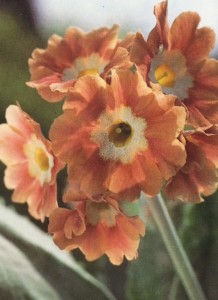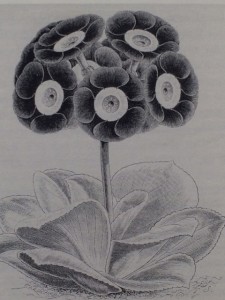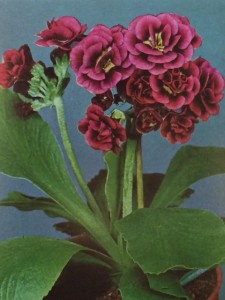AURICULA PRIMROSES
AURICULA PRIMROSES
When we think of primroses, the first thing that comes to mind are the ‘Pacific Giant’ hybrid primroses we see in garden centers. Actually hundreds of species of Primula are in existence, and some species have been brought into gardens and significantly developed. The auricula primroses, members of the species P. auricula, have been grown in gardens since the 1500s. They have evergreen leaves that curl around in a way that resembles the ear of a bear. When first cultivated, they were called ‘Bear’s Ears’. Charles l’Ecluse (known as Clusius) is the first person known to have grown auriculas in a garden. This was after 1573; he grew two kinds. The first auriculas grown in England are illustrated first left above, in a woodcut from Gerard’s Great Herbal of 1596. By 1639, at least 15 different colors and even striped forms were grown. Auriculas were a popular plant beginning in the early eighteenth century when keen collectors began to grow and exhibit them in competitions. These growers were called ‘florists’. Several specialized classes of auriculas came into existence over the following centuries. Potted plants were (and still are) exhibited in flower on black painted shelves in a stage-like display. The black background highlights the beautiful colors of the flowers. Auriculas do have an extremely wide color range, much greater than practically every other kind of flower. The second picture shows a tawny-colored auricula, a color popular in the 1600s. Auriculas were extremely popular in the nineteenth century, but curiously, are not well-known today.
Auriculas are native to the Alps and prefer gritty, moist, well-drained soil with a good amount of humus. They are tolerant of alkalinity and extremely winter hardy to USDA climate zone 3, or even zone 2 if covered with snow all winter. This means they are perfectly suited to growing all over Montana. They are shade plants, especially when grown at lower altitudes. The individual plants are small, only about 8 to 12 inches tall when blooming. The engraving third from left depicts a garden auricula from 1908. A gardener must watch that vigorous neighboring plants do not overtake them. Being evergreen, they grow rather slowly. I found that a mulch of sharp grit, about the diameter of turkey grit, is excellent for them and will discourage slugs. Auriculas thrive when grown organically and enjoy soil amendments such as bone meal, composted manure, kelp meal, wood ashes, and grit for excellent drainage.
The classes of exhibition auriculas are usually grown in pots and are smaller and less vigorous than garden auriculas. The pots used to grow them are taller than average, as the plants have a long tap root. Growers commonly use an organic soil potting mix with added grit, bone meal and wood ashes. Grit is especially important for drainage, but also for itsmineral content. Indeed, the flowers have a wonderful mineral-floral fragrance unlike any other. The last picture above shows a double exhibition auricula.
Auriculas are available from specialist growers as plants or seed. I grow mine from seed planted in a fine, fast-draining seedling mix, covered with glass and placed in a shaded cold frame. I plant seeds in late fall or winter, so the seeds have a cold period before they sprout in the spring. The plants are usually large enough to pot on by midsummer. Mature plants are best divided midsummer. I would urge gardeners to try auriculas; they are beautiful and rewarding to grow. If grown in the garden, they might be best appreciated in raised beds, where their delicate flowers can be observed.




